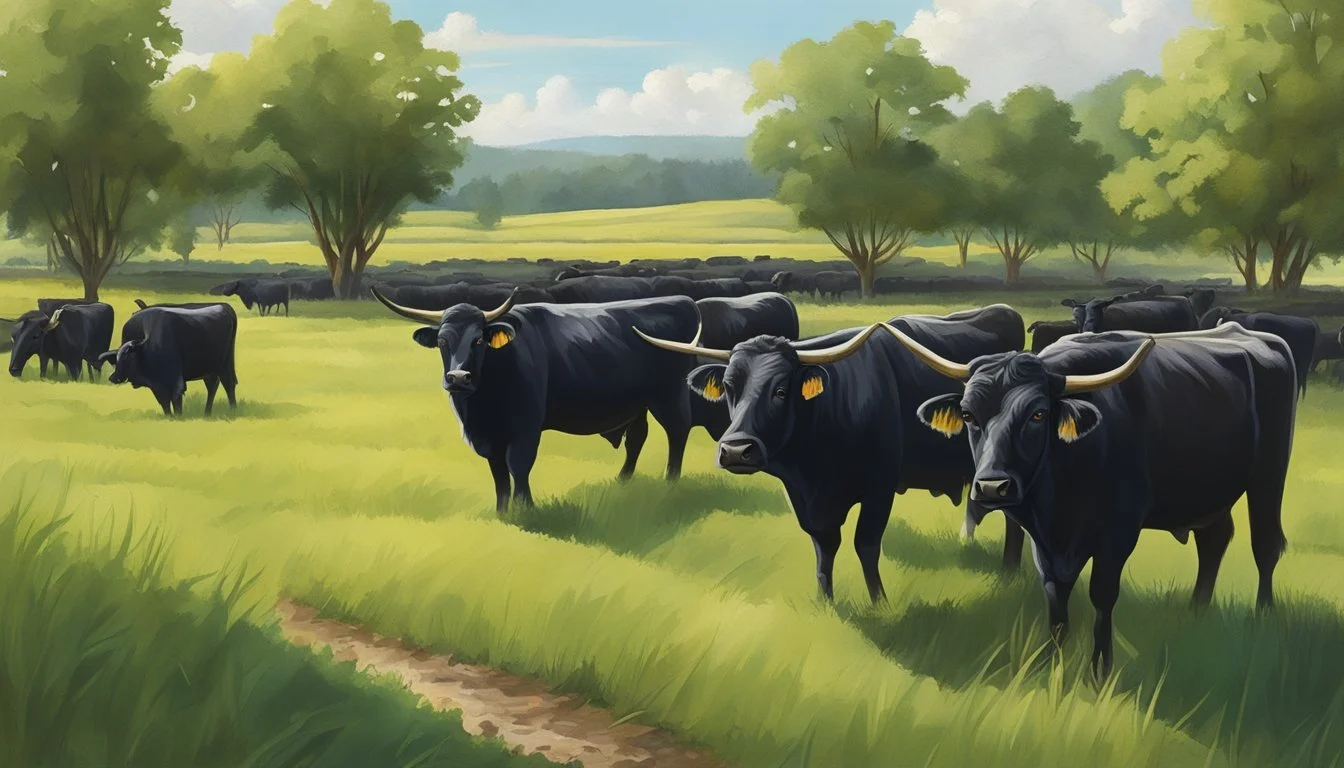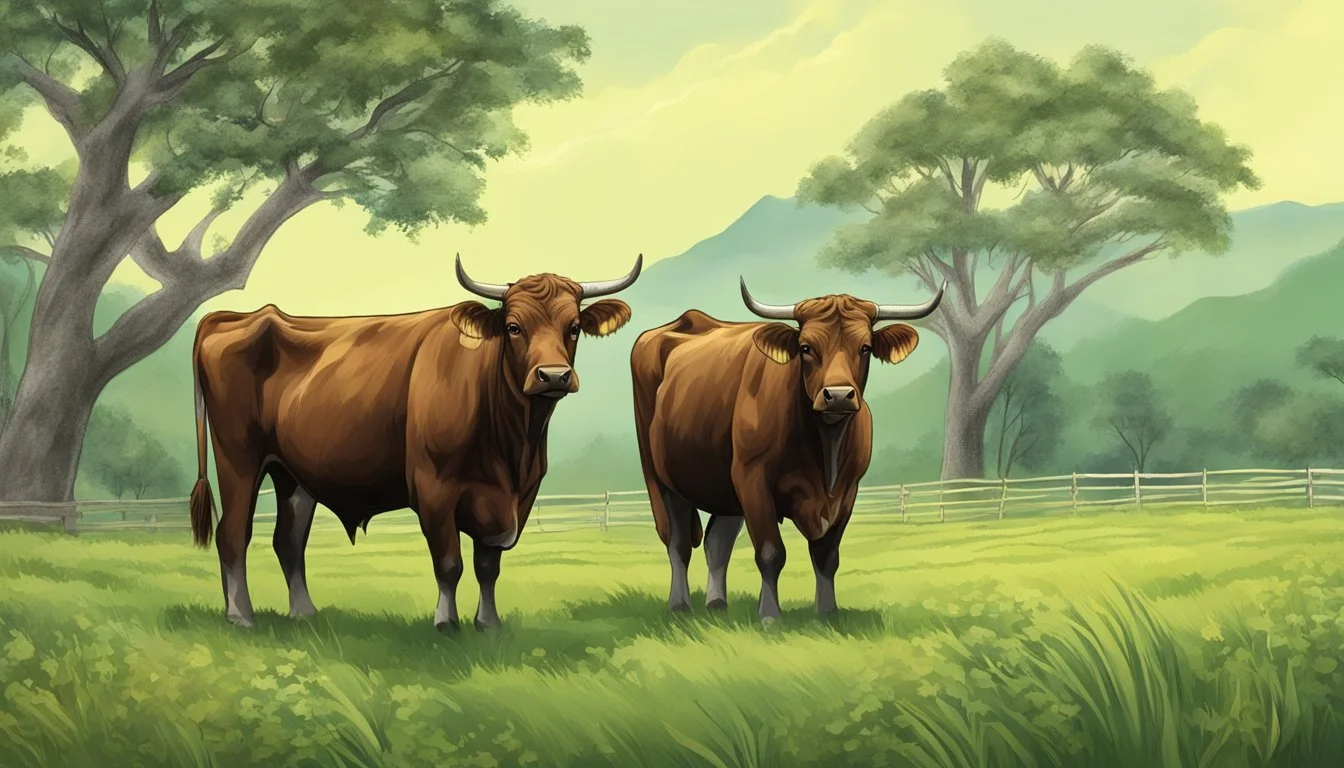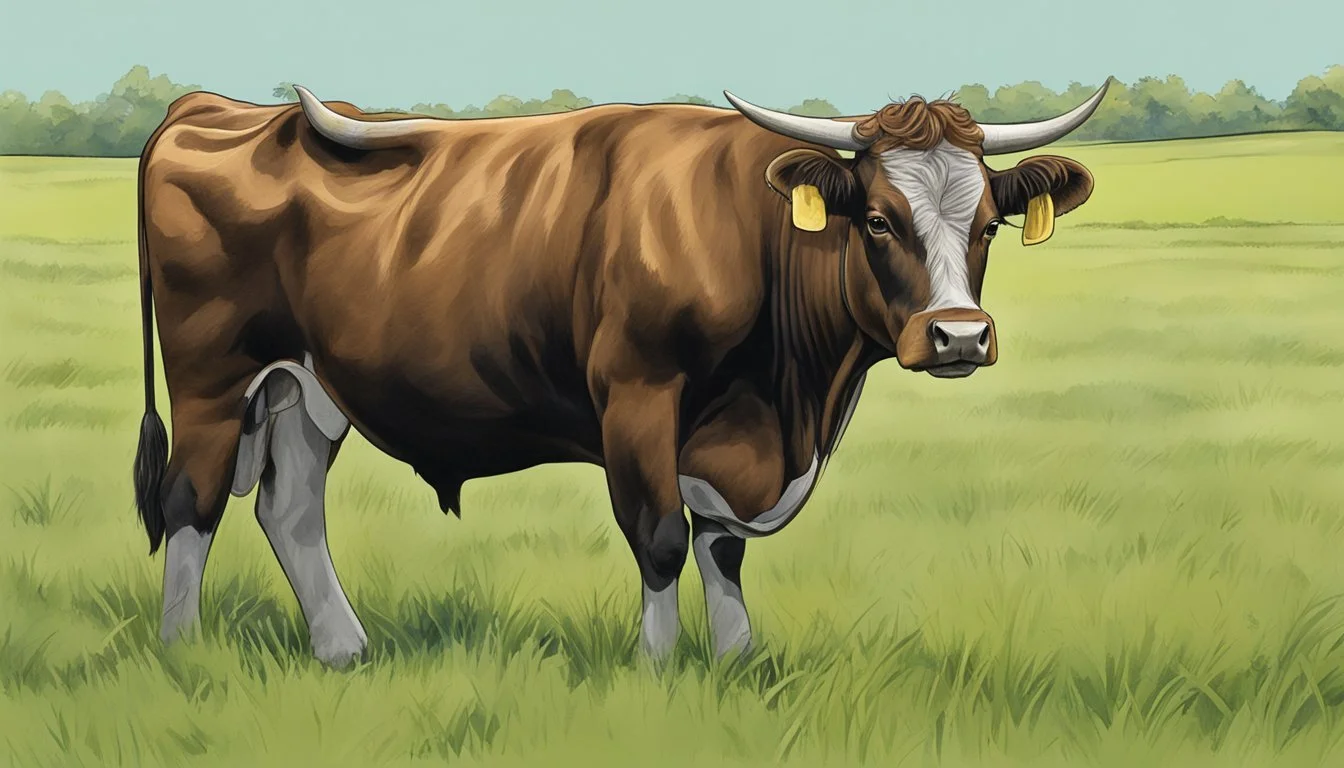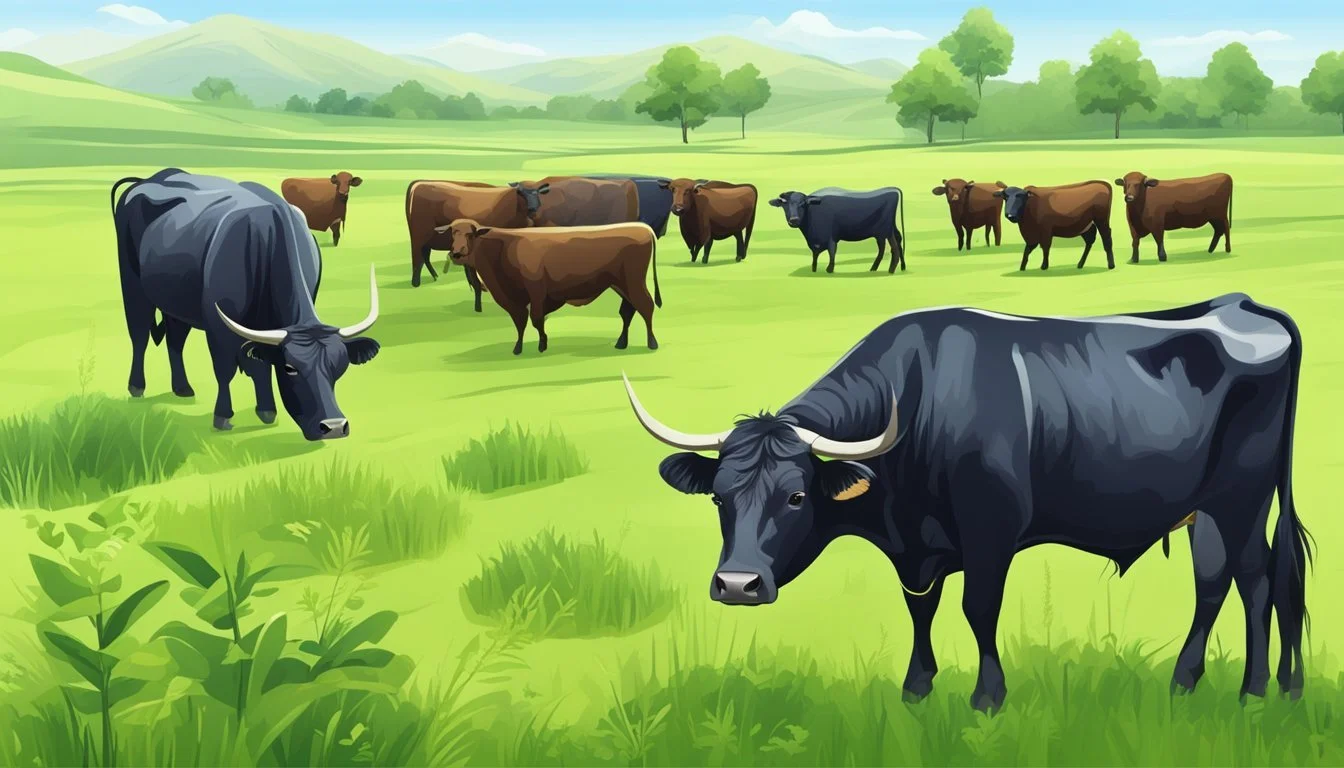Dexter Cattle and Soil Health
Exploring the Symbiotic Benefits
Dexter cattle are a small breed known for their hardiness and versatility, traits that make them particularly suitable for sustainable farming practices. As interest in environmentally friendly agriculture grows, the role of these cattle in maintaining and improving soil health warrants attention. Soil health is an essential component of an agroecosystem, influencing water retention, nutrient cycling, and overall land productivity. Dexter cattle, with their lighter weight and efficient grazing, can help manage pastureland in a way that supports soil structure and fertility.
The connection between Dexter cattle and soil health is a symbiotic one. Through managed grazing, these cattle can help to prevent overgrazing—a common issue with larger breeds—which in turn reduces soil compaction and erosion. Healthy soil is full of life and Dexter cattle contribute to this vitality by stimulating plant growth and aiding in the breakdown of organic matter through their manure, providing essential nutrients back into the soil. This integrated approach to farming recognizes the importance of livestock as a component of the ecosystem rather than a separate entity.
Farmers keeping Dexter cattle are often proponents of pasture-based systems that stand in contrast to conventional, grain-intensive cattle rearing. Pastures that are well-kept and grazed in a rotational manner by Dexter cattle can demonstrate increased resilience, promoting biodiversity both above and below the soil surface. This method of grazing encourages a variety of plant species to grow, which can lead to more stable soil aggregates and improved soil structure. Understanding the relationship between Dexter cattle grazing patterns and soil health indicators is crucial for those aiming to foster sustainable agricultural landscapes.
The Dexter Breed: An Overview
Dexter cattle offer a unique blend of advantages, from their compact size and hardy nature to their varied color patterns and dual-purpose utility. They originated in Ireland and are distinguished by their petite stature with both horned and polled varieties.
Origins in Ireland
The Dexter breed has its roots in the southern part of Ireland, where it emerged in the 18th century. Developed in County Kerry, these cattle are considered one of the smallest naturally occurring breeds. They were named after a man, Dexter, who was a prominent figure in the farming community on Valentia Island and are believed to have contributed to the breed's development.
Physical Characteristics
Dexter cattle are characterized by their compact size, making them well-suited for smaller farms or homesteads. Despite their small stature, they are known for their strength and hardiness.
Height: Typically between 36 to 48 inches at the shoulder
Weight: Cows generally weigh around 750 pounds, while bulls can weigh up to 1,000 pounds
Body: They exhibit a broad body with well-rounded hindquarters
The breed is adaptable, able to thrive in various climates and pasture conditions while maintaining good health and productivity.
Dexter Cattle Colors
The coat color of Dexter cattle typically comes in three solid colors:
Black
Red
Dun
Rarely, these cattle may have some white markings, but standard breed coloration is generally solid without extensive white. Their varied coat colors and solid patterns have become a recognized feature of the breed. Whether horned or polled, Dexters retain the same color traits, contributing to their breed identity.
Dexter Cattle in Agriculture
Dexter cattle are increasingly cherished in agriculture due to their versatile role and manageable size. These attributes make them particularly appealing for various scales of farming operations, from small homesteads to larger agricultural enterprises.
Dexter as a Dual-Purpose Breed
Dexter cattle, a breed originating from Ireland, have cemented their status as a compelling dual-purpose breed, adept at producing both high-quality beef and rich milk. They are smaller in stature compared to standard cattle breeds, a trait that often translates to lower maintenance and feed costs for farmers. Breeders recognize Dexters for their excellent feed conversion, providing a cost-effective option for livestock on the farm with an average yield of approximately 400 pounds of beef per animal. The American Dexter Cattle Association (ADCA) being the primary body for breed standards, emphasizes their milk production quality, noting that despite their compact size, Dexters can produce a milk yield suitable for both home and commercial dairy production.
Popularity Among Homesteads
Within the realm of smaller-scale agriculture, such as homesteads, Dexter cattle have gained popularity for their adaptability and the ease with which they can be integrated into farm operations. Homesteaders often prefer Dexter cattle due to their manageable size, which makes them less intimidating and easier to handle than larger breeds. The breed's versatility and gentle disposition make it a favorite choice among farmers who are looking for efficient and sustainable livestock options. Through the support of breeder networks and the ADCA, these cattle are becoming a mainstay in agricultural communities, widely appreciated for their contributions to the land and the lifestyle of their caretakers.
Dexter Cattle and Soil Health
Dexter cattle play a pivotal role in maintaining soil health, which is vital for sustainable agriculture. Their size and behavior can benefit soil structure, nutrient cycling, and grazing practices.
Importance of Soil Structure
Soil health is dependent on its structure which is influenced by the presence and activity of livestock like Dexter cattle. Dexter cattle, being smaller than many breeds, cause less compaction of soil, maintaining aeration and water infiltration. They support the development of soil aggregates which are essential for root growth and microorganism activity. Optimal soil structure can also reduce runoff and soil erosion.
Enhancing Nutrient Cycling
The grazing patterns of Dexter cattle facilitate effective nutrient cycling within the soil ecosystem. As they graze, their manure adds organic matter and nutrients like nitrogen, phosphorus, and potassium back to the soil. This incorporation of manure not only fertilizes the pasture but also stimulates microbial activity, which plays a significant role in decomposing plant residues and recycling soil nutrients.
Nutrient Inputs:
Nitrogen (N)
Phosphorus (P)
Potassium (K)
Sustainable Grazing Practices
Sustainable grazing practices are at the heart of the relationship between Dexter cattle and soil health. Their ability to thrive on pasture-based diets with little need for grain supplementation contributes to the reduction of overgrazing risks. Implementing a rotational grazing system with Dexter cattle can enhance pasture management, giving grasses time to recover, which in turn supports soil conservation and biodiversity. Through such agricultural practices, Dexter cattle not only contribute to livestock production but also to the overall health of the agricultural ecosystem.
Reproductive Traits of Dexter Cattle
Dexter cattle are renowned for their reproductive efficiency, exhibiting characteristics such as calving ease and reliable fertility. They are valued for their maternal qualities and are considered a breed with a straightforward breeding cycle.
Calving Ease and Mothering
Dexter cattle generally have a reputation for calving ease, which greatly reduces the need for human intervention during the birthing process. Their offspring tend to be small, contributing to fewer complications during labor. Dexter mothers show strong maternal instincts, ensuring high survival rates for calves. They are known to be docile in nature, which extends to their behavior around their young, making them attentive and protective.
Fertility and Breeding
With regard to fertility, Dexter cattle are acknowledged for their ability to breed back quickly after calving. They possess a consistent fertility rate and can maintain yearly calving with proper management, supporting a sustainable cattle operation. Additionally, breeding practices for Dexter cattle are amenable due to their size and temperament, and bulls are known for their vigor and effectiveness. While Dexter cattle are mainly raised for meat, breeding them can also support dairy production, as some cows are capable of producing a moderate quantity of milk, with reports suggesting an average of 2-3 gallons per day when grass-fed.
In summary, Dexter cattle exhibit desirable reproductive traits that contribute to their growing popularity among small-scale farmers and those looking for an adaptable and manageable breed.
Dexter Cattle Productivity
Dexter cattle are renowned for their dual-purpose capabilities, serving as both milk and beef providers. Their smaller size translates to efficiency in production, making them well-suited for smaller farms.
Milk Production
Dexter cows offer a notable milk yield, especially considering their compact frame. The average milk production for a Dexter cow ranges from 1.5 to 2.5 gallons per day. What distinguishes their milk is the high butterfat and protein content, which often measures around 4% butterfat and 3.5% protein. This rich milk composition is ideal for creating various dairy products such as cheese and butter.
Beef Production
When it comes to meat production, Dexter cattle also excel. Their meat is appreciated for its high quality and excellent marbling, which contributes to flavorful and tender cuts. The average weight for processed meat from a Dexter varies, but they can yield approximately 50% of their body weight in meat. Their efficiency in converting feed to meat makes them a sustainable choice for meat producers focusing on quality over quantity.
Health and Management
In the cultivation and maintenance of Dexter cattle, preserving health and controlling pests are paramount processes. Effective management involves tactics that safeguard cattle welfare while also promoting soil health.
Disease and Parasite Control
Dexter cattle are known for being hardy; however, they are not immune to disease and parasites. Parasite control is fundamental, as external parasites like flies, lice, and ticks can cause significant irritation and stress to livestock. This stress can lead to reduced grazing efficiency and overgrazing, impacting soil structure. Ensuring regular use of cattle oilers can mitigate these issues by delivering appropriate insecticides to the animals, hence reducing the parasite burden without necessitating stressful handling procedures.
Handling and Welfare
Good animal welfare is intrinsically linked to appropriate handling. Stress during handling can have adverse effects on health and productivity. Dexter cattle require handling facilities that are designed to minimize stress, which in turn can prevent erratic behaviors that might be detrimental to soil compaction and structure. Livestock management strategies should include training for handlers to use calm and consistent methods to maintain a relaxed environment.
Pest Management Strategies
Integrated pest management (IPM) combines biological, cultural, and chemical practices to control pests in an economically and ecologically sound manner. Chemicals, while effective, should be used judiciously to reduce any potential negative impacts on soil health. By integrating the use of cattle oilers, physical barriers, and biological controls, farmers can target pests like flies without causing unnecessary chemical runoff which could harm the soil ecosystems. These strategies align with profitability, by reducing economic losses through efficient pest control while safeguarding the environment.
Environmental and Economic Impact
The health of soil and the profitability of farming practices are deeply intertwined, with sustainable approaches yielding benefits for both the environment and the economy.
Reducing Soil Compaction
Dexter cattle, being a smaller breed, exert less pressure on the land, which minimizes soil compaction. Compacted soil can inhibit root growth, reduce air and water infiltration, and ultimately lead to decreased plant productivity. By preventing soil compaction, Dexter cattle help maintain the soil's physical structure, thereby supporting its ability to sustain plant life and contribute to healthier ecosystems.
Enhancing Water Retention
Healthy soil with good structure enhances water retention, which is crucial for maintaining soil moisture levels, especially during dry periods. Dexter cattle contribute to the accumulation of organic matter in the soil through their manure. Increased organic matter improves water retention, leading to more resilient soil that can support crops during water scarcity and reduce dependence on irrigation.
Profitability for Farmers
Farmers who integrate Dexter cattle into their agricultural practices may experience increased profitability due to several factors:
Lower input costs: Due to the breed's hardiness and efficient grazing, farmers may spend less on feed and medical treatments.
Improved soil health: This can lead to higher yields and better quality produce.
Sustainable agriculture: By enhancing soil qualities and reducing the need for chemical inputs, farmers position themselves as stewards of the land, potentially accessing niche markets that value sustainable practices.
The balance of environmental care and operational profitability demonstrates that sustainable agriculture is not only viable but essential for long-term success.
Cattle to Consider for Your Farm
When selecting livestock for a farm, the adaptability to various environments and size of the breed are critical factors that impact farm management and efficiency. Dexter cattle are considered an excellent option, boasting characteristics that are beneficial for small-scale farms and homesteads.
Adaptability to Diverse Environments
Dexter cattle are known for their hardiness and adaptability. They can thrive in different climates, from damp grasslands to arid regions. Their resilience makes them efficient grazers, able to forage and maintain good health on a pasture-based diet, with minimal need for grain supplementation. This adaptability reduces feed costs, and their grazing habits contribute positively to soil health.
Advantages of Small Size
The compact size of Dexter cattle leads to numerous benefits:
Consume Less Feed: They require less feed compared to larger cattle breeds, which can ease the financial burden on the farm.
Ease of Handling: Their friendly nature and manageability make them a safer livestock option, particularly reducing the risk of injury to farmers.
Efficient Land Use: The smaller stature allows for more animals per acre, maximizing the utility of available land on homesteads.
Long Lifespan: A longer average lifespan implies sustained productivity on the farm.
Dexter cattle's characteristics, such as their red or black coloration and proportionately smaller size, alongside their capability to adapt to varied environments, make them a reliable and sustainable choice for farmers seeking to balance livestock management with soil health objectives.
Historical Significance and Cultural Impact
Dexter cattle have a longstanding place in agricultural history, while soil health reflects an evolving understanding of land stewardship. Each has impacted culture differently yet significantly.
Dexter's Roots and Spread
The Dexter breed of cattle originated in Ireland, specifically the southwestern part. It developed as a distinct breed by the early 1800s. The Dexter is a small breed, resulting from the selective breeding of Kerry cattle by smallholder farmers. The breed's spread was marked by its registry in the English Herd Book starting in 1892. By 1924, the English Kerry and Dexter Cattle Society concentrated its efforts solely on promoting Dexter cattle, indicating the breed's growing popularity and significance in both beef and dairy production.
Symbolism and Influence
Dexter cattle and soil health possess unique cultural symbolism and influence. Dexters, due to their lineage from the rugged landscapes of Ireland, symbolize resilience and adaptability in agriculture. Their historical association with small-scale farming highlights a cultural shift towards sustainable and efficient livestock practices. On the other hand, soil health embodies the progression in agrarian stewardship. The analogy of soil as a living organism has deep roots, underscoring the crucial role it plays in sustaining life and prompting shifts in policy and conservation efforts that better reflect an understanding of its living nature.








